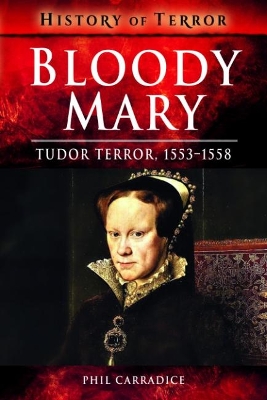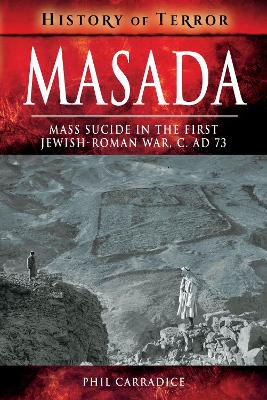A History of Terror
3 total works
When Mary Tudor, eldest daughter of Henry VIII, succeeded to the throne of England in 1553 it was with wild rejoicing and a degree of popularity rarely seen on the accession of a British monarch. Yet at her death five years later she was almost universally reviled and hated by her people so much so that she was posthumously awarded the sobriquet Bloody Mary.
Mary's revenge on the church and on a religion she hated was swift and total. Noblemen like the Duke of Northumberland, would-be queens like Lady Jane Grey, churchmen like Thomas Cranmer and bishops Latimer and Ridley, Mary's fires or the executioner's axe ended the lives of all of them.
During her brief reign she restored the Catholic faith to England and had over 280 Protestant martyrs burned at the stake. For a reign that looked so promising Mary's brief period in power brought the greatest officially sanctioned religious bloodletting the country had ever seen. And at the end, the stench of the execution fires and the grey smoke that settled like a pall across the country seemed to epitomize the reactionary forces that had assumed control.
Mary's revenge on the church and on a religion she hated was swift and total. Noblemen like the Duke of Northumberland, would-be queens like Lady Jane Grey, churchmen like Thomas Cranmer and bishops Latimer and Ridley, Mary's fires or the executioner's axe ended the lives of all of them.
During her brief reign she restored the Catholic faith to England and had over 280 Protestant martyrs burned at the stake. For a reign that looked so promising Mary's brief period in power brought the greatest officially sanctioned religious bloodletting the country had ever seen. And at the end, the stench of the execution fires and the grey smoke that settled like a pall across the country seemed to epitomize the reactionary forces that had assumed control.
In the spring of 73 AD the rock fortress of Masada on the western shore of the Dead Sea was the site of an event that was breathtaking in its courage and self-sacrifice. Here the last of the Jewish Zealots who, for nearly eight years, had waged war against the Roman occupiers of their country made their last stand.
The Zealots on Masada had withstood a two-year siege but with Roman victory finally assured, they were faced by two options: capture or death. They chose the latter and when the Roman legions forced their way into the hill fort the following morning they were met only with utter silence by row upon row of bodies. Rather than fall into enemy hands the 960 men, women and children who had defended the fortress so heroically had committed suicide.
The story of the siege and eventual capture of Masada is unique, not just in Israeli legend but in the history of the world. It is a story of bravery that even the Roman legionaries, well used to death and brutality, could see and appreciate. It was a massacre but a massacre with a difference: carried out by the victims themselves. The story of Masada has gone down in Israeli and Jewish folklore. It is little known elsewhere and it is time to redress the balance.
The Zealots on Masada had withstood a two-year siege but with Roman victory finally assured, they were faced by two options: capture or death. They chose the latter and when the Roman legions forced their way into the hill fort the following morning they were met only with utter silence by row upon row of bodies. Rather than fall into enemy hands the 960 men, women and children who had defended the fortress so heroically had committed suicide.
The story of the siege and eventual capture of Masada is unique, not just in Israeli legend but in the history of the world. It is a story of bravery that even the Roman legionaries, well used to death and brutality, could see and appreciate. It was a massacre but a massacre with a difference: carried out by the victims themselves. The story of Masada has gone down in Israeli and Jewish folklore. It is little known elsewhere and it is time to redress the balance.
In the summer of 1934 Adolf Hitler planned and conducted the most ruthless purge of his thirteen-year period as leader of Germany. The victims were not political opponents but friends, colleagues and fellow fascists who had helped the Nazi Party in its rise to power.
The Night of the Long Knives broke the back and the will of the Sturmabteilung, the SA, the brawling street thugs who had bludgeoned political opposition into submission. The SA's ruthless bullyboy tactics played no small part in Hitler's establishment of a dictatorship that was to influence affairs in Germany - and the world - throughout the 1930s and beyond.
In some respects the purge was inevitable. Hitler had to eliminate all potential rivals if he was to consolidate his position of power. And that meant that friends like Ernst Roehm, former German Chancellor Kurt von Schleicher, and even former party comrades like Gregor Strasser were summarily shot without trial. Above all it was the SA that the army, the industrialists and, more than anyone else, Adolf Hitler feared. Roehm enjoyed a popularity that almost rivalled Hitler's and so he had to go.
It was also an opportunity to settle personal scores. The Night of the Long Knives was a cull that eliminated somewhere between 300 and a thousand victims, the exact number has never been clear, many of them innocent of any intention to rival Hitler. It remains one of the most significant killings of modern times.
The Night of the Long Knives broke the back and the will of the Sturmabteilung, the SA, the brawling street thugs who had bludgeoned political opposition into submission. The SA's ruthless bullyboy tactics played no small part in Hitler's establishment of a dictatorship that was to influence affairs in Germany - and the world - throughout the 1930s and beyond.
In some respects the purge was inevitable. Hitler had to eliminate all potential rivals if he was to consolidate his position of power. And that meant that friends like Ernst Roehm, former German Chancellor Kurt von Schleicher, and even former party comrades like Gregor Strasser were summarily shot without trial. Above all it was the SA that the army, the industrialists and, more than anyone else, Adolf Hitler feared. Roehm enjoyed a popularity that almost rivalled Hitler's and so he had to go.
It was also an opportunity to settle personal scores. The Night of the Long Knives was a cull that eliminated somewhere between 300 and a thousand victims, the exact number has never been clear, many of them innocent of any intention to rival Hitler. It remains one of the most significant killings of modern times.


